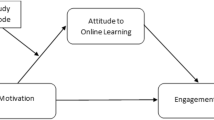Abstract
Drawing upon Freud's seminal discussion of psychological identification vis-a-vis group psychodynamics, this study investigated the relationship between degree of student identification with an instructor and students' ratings of instructional effectiveness. Specifically, it was hypothesized that students who highly identify with their instructor will rate the course more favorably, perceive greater progress on their part toward course related objectives, and report higher motivation to learn than students who do not identify with their instructor. Using a 50 item personality trait Q-sample, 96 undergraduates from eight different courses taught by three different instructors were asked to describe the instructor, their “actual” self, and their “ideal” self; Q-sorts for the instructor and “ideal” self were correlated separately for each student as the measure of identification. Instructional effectiveness was assessed using the Kansas State IDEA form. Correlational and path analyses of the data provided support for the hypothesis. Results are discussed in light of the unique contribution made by the traditional notion of identification to instructional outcomes and evaluation.
Similar content being viewed by others
References
Anderson, N. (1968). Likeableness ratings of 555 personality-trait words, Journal of Personality and Social Psychology, 9: 272–279.
Anderson, W. T., Alpert, M. and Golden, L. (1978). “A comparative analysis of student—teacher interpersonal similarity/dissimilarity and teaching effectiveness”, Journal of Educational Research, 72: 36–44.
Brown, S. R. (1980). Political Subjectivity. New Haven: Yale University Press.
Costin, F., Greenough, W. T. and Menges, R. J. (1971). “Student ratings of college teaching: Reliability, validity, and usefulness”, Review of Educational Research, 41: 511–535.
Crites, J. O. (1962). “Parental identification in relation to vocational interest development”, Journal of Educational Psychology, 53: 262–270.
Duncan, O. D. (1966). “Path analysis: Sociological examples”, American Journal of Sociology, 72: 1–16.
Feldman, K. A. (1976). “The superior college teacher from the students' view”, Research in Higher Education, 5: 243–288.
Foote, N. (1951). “Identification as a basis for a theory of motivation”, American Sociological Review, 16: 14–21.
Freud, A. (1952). “The role of the teacher”, Havard Educational Review, 22: 229–234.
Freud, S. (1922). Group Psychology and the Analysis of the Ego. London and Vienna: International Psychoanalytic Press.
Fulcher, D. G. and Anderson, W. T. (1974). “Interpersonal dissimilarity and teaching effectiveness: A relational analysis”, Journal of Educational Research, 68: 19–25.
Hall, D. T. (1970). “The effect of teacher-student congruence upon student learning in college classes”, Journal of Educational Psychology, 61: 205–213.
Hollander, E. P. and Julian, J. W. (1969) “Contemporary trends in the study of leadership processes”, Psychological Bulletin, 71: 387–397.
Hoyt, D. P. (1973). Instructional effectiveness: I. Measurement of effectiveness. Manhattan: Kansas State University.
Isaacson, R. L., McKeachie, W. J. and Milholland, J. E. (1963). “Correlation of teacher personality variables and student ratings”, Journal of Educational Psychology, 54: 110–117.
Kagan, J. (1958). “The concept of identification”, Psychological Review, 65: 296–305.
Kelman, H. (1958). “Compliance, identification, and internalization: three processes of attitude change”, Journal of Conflict Resolution, 2: 51–60.
McKeachie, W. J. (1979). “Student ratings of faculty: a reprise”, Academe, (October), pp. 348–397.
Rogers, C. (1959). “Significant learnings: In therapy and in education”, Educational Leadership, 16: 232–242.
Sherman, B. R. and Blackburn, R. T. (1975). “Personal characteristics and teaching effectiveness of college faculty”, Journal of Educational Psychology, 67: 124–131.
Stavsky, W. H. (1957). “Using the insights of psychotherapy in teaching”, The Elementary School Journal, 58: 28–35.
Stephenson, W. (1953). The Study of Behavior. Chicago: University of Chicago Press.
Tyler, L. J. (1967). “The utilization of psychoanalytic concepts for assessing classroom transaction”, The Journal of Educational Research, 60: 260–266.
White, B. J. (1959). “The relationship of self concept and parental identification to women's vocational interests”, Journal of Counseling Psychology, 6: 202–206.
Author information
Authors and Affiliations
Rights and permissions
About this article
Cite this article
Thomas, D., Ribich, F. & Freie, J. The relationship between psychological identification with instructors and student ratings of college courses. Instr Sci 11, 139–154 (1982). https://doi.org/10.1007/BF00154884
Issue Date:
DOI: https://doi.org/10.1007/BF00154884




